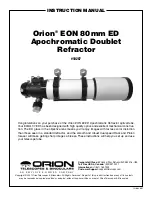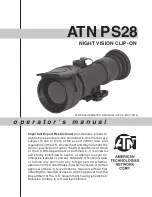
3
2
Introduction
Your Vega 360 is a refractor telescope. Refractors were the first
types of telescopes invented. A refractor telescope collects light
through a large objective lens and directs it through the telescope
to the eyepiece for magnification. Your telescope will enable you to
see many interesting objects in the night sky as well as giving you an
up-close view of remarkable things here on earth, from animals and
landforms to sporting events. The information in this guide will help
you get the most from your telescope.
Getting Started
Remove all of the components from the box. Using the list and picture
below, identify each of the parts of your telescope. It is recommended
that you keep your telescope box for long-term storage, or should you
ever need to return the telescope for service.
Component parts:
A. Optical tube with rack and pinion focuser (pre-assembled)
B. Tripod with altazimuth mount
C. Diagonal mirror
D. 20mm eyepiece
E. 9mm eyepiece
F. 2x erecting eyepiece (image erector)
1.
Optical tube:
Holds and protects the telescope’s main, or
objective, lens.
2.
Objective lens:
Gathers light from a distant object and brings that
light, or image, to a point or focus.
3.
Dust cap:
Protects the objective lens from scratches and dirt.
4.
Dew shield:
Prevents dew from forming on the lens at night and
acts as a sunshade to reduce reflections during the day.
5.
Eyepiece:
Brings the image from the telescope’s objective lens to
your eye. Your telescope comes with a low power eyepiece and a
high power one, too.
6.
Diagonal mirror:
Orients the image from your telescope so that it is
right-side up. It also makes it more comfortable to look at stars
high in the sky without bending down low.
7.
Focuser:
Turn the focusing knob to make images clearer.
8.
Altazimuth mount:
Holds the optical tube and allows you to adjust
the view up and down (altitude) and side-to-side (azimuth).
9.
Tripod:
Tabletop tripod supports the telescope and mount.
Let’s Look at Your Vega 360
Familiarize yourself with the parts of your telescope and their purpose.
1
3
4
5
6
7
8
9
2
(inside)
A
B
C
D
E
F



























